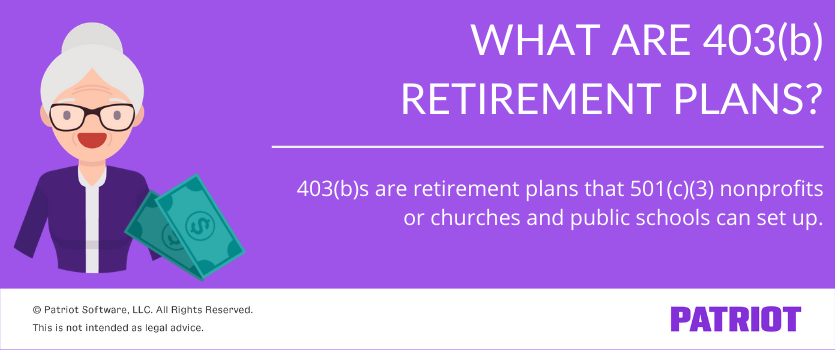Offering employees the opportunity to contribute to a retirement plan is a benefit many for-profit businesses provide. But, what about nonprofits? If you run a nonprofit with 501(c)(3) status, you can offer your employees a 403(b) retirement plan.
So, what is a 403(b) plan? Who can enroll? How does it differ from a typical 401(k) plan? Read on to find out the answers to these and other common questions about the plan.
What is a 403(b) plan?
A 403(b) plan is a type of retirement fund only 501(c)(3) nonprofits or churches and public schools can set up. Like 401(k) plans, 403(b)s have an annual contribution limit and allow both employees and employers to contribute. Unlike 401(k) plans, many 403(b)s aren’t subject to certain plan protections and strict reporting requirements.

Before we dive into 403(b) plans, let’s go over the types of organizations that can offer them:
Nonprofits with 501(c)(3) status: A nonprofit with 501(c)(3) status is a tax-exempt organization that has applied for and received the status from the IRS. 501(c)(3) organizations are public charities or private foundations that meet specific regulations.
Public schools: Public schools are educational institutions with faculty, curriculum, and students. This category includes public schools as well as state colleges and universities.
403(b) retirement plan: Q & A
If you’re eligible to set up a 403(b) retirement plan, you likely have some questions. Before deciding to implement this type of retirement plan, take a look at this question and answer section.
Are 403(b) plan contributions pre-tax or post-tax?
403(b) plan contributions are pre-tax deductions. This means you will withhold them from an employee’s wages before withholding taxes. A pre-tax contribution lowers an employee’s taxable income, lowering their tax liability. However, account holders will pay taxes on their 403(b) plan distributions.
There is a post-tax deduction option for 403(b) plans, which is known as a Roth 403(b). If an employee contributes to a Roth 403(b) plan, you’ll withhold taxes from those contributions. And, account holders will not pay taxes on their Roth 403(b) plan distributions.
What is the difference between 401(k) and 403(b) plans?
So, why would you opt to set up a 403(b) plan for your organization when you could just set up a 401(k) plan?
Here are a few differences between 401(k) and 403(b) plans:
- Many 403(b)s aren’t subject to the Employee Retirement Income Security Act (ERISA), which regulates nondiscrimination testing and reporting requirements
- 403(b) funds tend to have a shorter vesting time than 401(k) funds
- 403(b) plans let employees make an additional catch-up contribution if they’ve worked at an organization for 15 years or more
- Many 403(b) plans are administered by insurance companies, whereas 401(k)s are administered by mutual fund companies
If you want, you can decide to offer both 403(b) and 401(k) plans to employees.
Which employees can contribute?
Employees in 501(c)(3) tax-exempt organizations, public schools, and churches can contribute to a 403(b) plan. However, you can exclude some employees from your organization’s 403(b) plan.
Employers can exclude employees who:
- Work fewer than 20 hours per week
- Will contribute $200 or less annually
- Participate in a 401(k) plan
- Are non-resident aliens
- Are students
Can employers contribute to an employee’s plan?
Employers can decide to contribute to their 403(b) plans.
However, contributing to your employees’ 403(b)s turns the plan into an employer-sponsored program. As a result, you have to comply with the same ERISA guidelines and reporting requirements for 401(k)s.
What are the contribution limits?
403(b) plans follow the same contribution limits as 401(k)s.
In 2020, employees can contribute up to $19,500 to their 403(b) plan. If an employee contributes to both a 401(k) and 403(b) plan, their total contribution can’t be more than the $19,500 limit.
If you also contribute to an employee’s 403(b) retirement plan, your combined contributions must be less than $57,000 (2020) or 100% of the employee’s most recent annual salary, whichever is less.
Employees who are 50 and older can make additional catch-up contributions of $6,500, making their annual contribution total $26,000.
Unlike 401(k) plans, there’s a 403(b) plan exclusive benefit for employees with 15 or more years of service. Employees with 15 or more years of service at a qualifying organization can contribute an additional $3,000 a year, up to $15,000.
When can account holders withdraw funds?
Account holders must be 59.5 years old to begin taking 403(b) plan distributions.
Although account holders can withdraw funds before they’re 59.5 years old, they’ll owe a 10% penalty unless they meet qualifying exemptions.
One exemption example would be withdrawing money early to pay for unreimbursed medical expenses. However, the SECURE Act of 2019 expanded penalty-free withdrawal opportunities to also include birth or adoption.
A word on 403(b) plan setup
You must have a written plan to set up a 403(b) plan. The written plan should outline the plan, including eligibility, contributions, and termination.
When setting up your plan, you can automatically enroll employees if the:
- Plan allows employees to contribute
- 403(b) contains an automatic contribution arrangement in the written plan
- Employee does not opt-out of automatic enrollment
If your 403(b) plan is subject to ERISA, you must undergo nondiscrimination testing annually. This ensures that your highly-compensated employees aren’t receiving higher benefits than the rest of your staff.
Have you decided to offer your employees a 403(b) plan? Great! But, don’t forget to deduct employee contributions from their wages. With Patriot’s payroll software, you can set up contribution amounts for your employees and ensure taxes are accurately computed on taxable wages. Get your free trial now!
This is not intended as legal advice; for more information, please click here.


